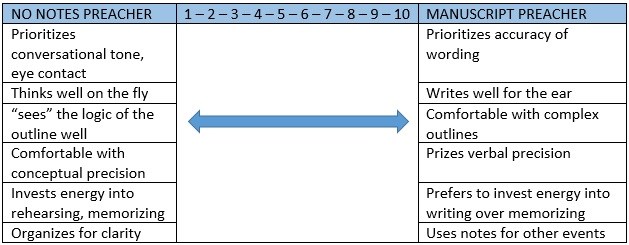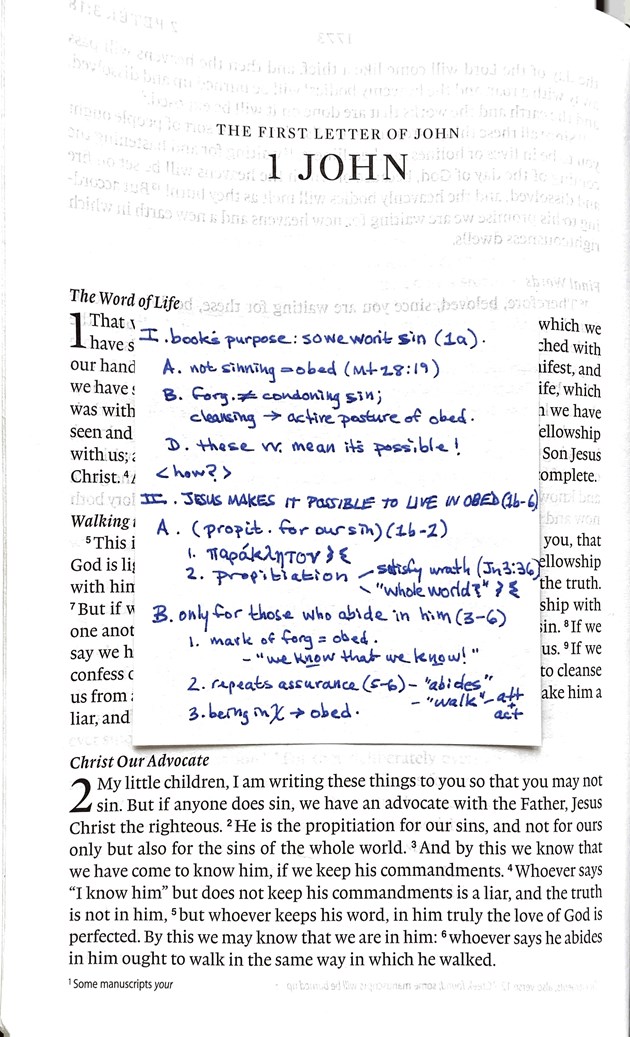Skill Builders
Article
Preaching Without Notes ... Almost

Editor’s Note: I (Andrew Finch) asked Lucas O’Neill to write this article a few months ago after he talked with me about the post-it notes he takes with him to the pulpit. I found it amazing that he could preach from just a few post-it notes.
But I think the pointers he gives us in this article ring even more true today for those of us who are preaching through a camera to our congregations right now.
The idea of using less notes to maintain eye contact is very important even when all we are doing right now is looking at a camera. Our hearers need to see us look at them rather than down at our notes or worse just read a manuscript in to the camera.
So please don’t read this article as a no-notes vs. manuscript article, read it as a way to help you better connect with your hearers during this time we are in now.
We were all students in a doctoral level preaching course and part of the assignment was to preach a sermon with zero notes--nothing but the Bible. We were all nervous about it, but one student, an experienced pastor, was particularly vocal about being unable to do it. We encouraged him. Surely he could. And he almost did. He was in a groove with a strong introduction and smooth transition to his first point. Then nothing.
Should I or Should I Not Manuscript?
I understand why we were made to do it. Haddon Robinson’s strategy was to force us to preach once with no notes so that we could begin to develop the sense of it and hopefully commit to it. The goal was to preach so simply and clearly that notes were not necessary. Of course it would take practice. But the advantage is to heighten verbal communication and limit obstacles such as loss of eye contact and that weird thing that happens to the voice when it goes into reading mode.
But in the backs of our minds, we might fear the possibility of freezing like my peer did. With nothing to move him forward he went virtually catatonic for a painfully long time before he could finally proceed with his thoughts. Still, you might wonder about advantages to weaning off of notes.
To be clear, whether a preacher uses a full manuscript, an outline, or no notes at all should not be considered a matter of biblical fidelity. Some things are required of every preacher. Sticking with the text, explaining the meaning, keeping application tethered to the burden of the passage, honoring the voice of the text, for some examples. These really shouldn’t be debatable. But decisions about how much material besides the Scriptural text to take up with you to preach is far from the right/wrong arena. Yet I wouldn’t say it is simply a matter of style. It’s a matter of priorities.
Determining Your Priorities
Depending on what you value most in the communication of Scripture, you will decide to adopt an approach somewhere along the spectrum between no-notes and full manuscript.
The priorities should not include how long a process takes. We should be willing to put in the work necessary to do what is best. Nor should the priorities include the desire to publish the notes somewhere afterwards. Prepare a sermon for the preaching and worry about publishing it some other time. When you present your material somewhere to be read, then write it for the eye. For the sermon you want to have a sharp focus on preparing it for the ear.
Your priorities should be centered on what you most want to accomplish. In general, the manuscript or heavy-notes preacher wants to protect vocabulary precision. This does not mean that no-notes or minimal notes preachers are necessarily careless or that they are fuzzy in their theology. Rather, they are more comfortable with saying things in ways their minds can naturally produce in the moment.
No-notes or less-notes preachers want to protect a conversational tone and audience engagement. Some manuscript preachers are able to maintain plenty of eye-contact and preach what is written as if it is simply being spoken. Not many have that gift. Recently in a homiletics lab just after a student preached an obviously full-manuscript sermon, I asked him in front of the class, “Hey, that part about (some point he made), can you remind me what you were getting at there?” He recounted the point, with fuller details than he had in the sermon and with greater clarity. Then I said, “Do you see how you just did that without notes?” And, for him, he did better that way.
There is something to be said about a conversational tone in preaching. If you sit down to talk with a friend about something important but you pull out a stack of notes, that would be one way of doing it. But if you can look them in the eye, less concerned with precise wording and more concerned with delivering well-thought-through ideas in a natural way, you might be able to do it with more verve, more affection, more heart-felt expressiveness.
A recent book warns low or no-notes preachers that their lack of notes likely means lack of depth. This is a danger to be sure. In the effort to make the sermon simple, complex things can be left out when they should be tackled and explained. Sometimes you need to be exacting in your explanation of sensitive points. But while difficult subjects demand precision, I wonder: if heavy notes are necessary to communicate a concept, has the preacher really grasped it yet?
Similarly, there is a danger of showing off. People will be impressed by your ability to speak without pages of notes. But that risk also cuts the other way doesn’t it? Is the notes-heavy preacher showing off deep research ability? How well they can craft and wordsmith their sentences? Does the desire to get every word right also come with its own temptation toward pride? It’s a matter of the heart, not notes.
The question about notes will be determined, not by which is more faithful or humble. Rather, you will need to determine where along the scale you find yourself so that you can serve your listeners the best in your delivery.

No Notes Scale
Finding Your Comfort Zone
I’m kind of an in-between preacher on the above scale; you might be too. Most preachers are not a pure 1 or 10. I’m something like a 3 and here’s why:
I never could get into producing manuscripts for sermons. It isn’t that I don’t enjoy writing. I really do. But writing for the ear is another layer of challenge for me and, what’s more, when I am up there I feel like I need to say it the way I wrote it.
For me that is a hard thing to shake, and it results in the need to either memorize it or read it aloud to the congregation. I want to protect the conversational tone. But on the other hand there are certain steps in the exposition I want to make sure I follow. Certain statements that I don’t want to forget. I want some level of vocabulary or even structural precision. I’ve been preaching now for almost 25 years and there is a bit of an evolution to what I take up with me to preach.
I never wanted to take up so many sheets of paper up there that the listeners could see (or hear!) pages turning as I progressed through the sermon. I realized that if I would stick to one unit of Scripture and could really grasp the logic of the text, then in a real sense the text itself was my outline. This meant I needed less notes.
I began by taking up a long legal sheet folded in half in my Bible. I would open that up on the pulpit and that’s it, no fiddling with papers. Then I moved to 8.5x11 sheets, landscaped and cut in half. These fit easily into the Bible, nice and discreet. These days, I can get away with a couple of sticky notes on the pages of the Bible.
I write my outline out by hand with pencil. For me, that manual writing process helps me internalize the material in a way typing on a screen can’t. Then I really boil it down. All I need is my Big Idea, main points, and crucial subpoints. I usually squeeze in any needed cross-references and careful transitions (okay, I write really small). I also use little symbols, abbreviations, and one-word reminders to maximize space on the note. They only need to make sense to me! Everything that doesn’t make it onto the sticky notes is internalized (like the intro and conclusion for instance) and prompted by the actual words of the text as I move through it.

1 John Notes
What I have found in my own preaching is that I highly value a few things on the left side of the scale. I want to sound “in the moment” in a way that makes the listeners feel like I am saying something to them now, not reading something I have previously written. I like not needing a pulpit. While some would say I have lost something almost sacred, I would say they can now see my previously hidden Bible! As I stand there, it’s me, the Bible and them. That says something.
Yet I value precision of wording when it comes to key statements and tricky spots in the exposition. I need something to remind me what the cross-references are when I have them. And I also want to make sure the order of certain points are not jumbled. The result is that I am a minimalist when it comes to notes, but rarely am I ever up there with no notes at all.
You may not feel any compunction to move toward the left on the scale. But if you do, try to commit to these three disciplines and you will be well on your way.
Disciplines for Using Less Notes
1. Work hard at outlining for clarity.
Many preachers fail to outline well. If your pattern is to announce the verse, explain, apply, repeat, then you might be simply stringing together comments rather than working at a structure that will communicate clearly and compellingly. Pick up some classic homiletics texts and refresh yourself on basic outlining. Don Sunukjian’s Invitation to Biblical Preaching is a model of pristine outlining.
2. Mumble to yourself.
Alexander Hamilton was known for his spectacular skill with extemporaneous speech. But he was also known to pace in public muttering to himself. He would go over his thoughts, organize them, think them through, over and over. He also filled up most of his available time writing obsessively. His amazing speeches weren’t unrehearsed. He prepared.
3. Get clear on the text.
If there are any parts of the passage that are difficult for you to explain, it probably means you are still unclear on what it means. Practice explaining tough parts to a friend, and see if you’re able to make it clear to them quickly. If you find yourself stumbling or your friend is confused, you need more clarity.
Work at these three disciplines and, in time and with diligent persistence, you will need less notes when you preach.
Less Notes in Action
Lucas O’Neill is a Clinical Associate Professor of Homiletics at Trinity Evangelical Divinity School (Deerfield, IL). He has pastored Christian Fellowship Church (Itasca, IL) for over ten years, and is the author of "Preaching to Be Heard" (Lexham Press, 2019).











